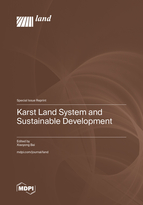Karst Land System and Sustainable Development
A special issue of Land (ISSN 2073-445X).
Deadline for manuscript submissions: closed (3 July 2023) | Viewed by 31461
Special Issue Editor
Interests: karst; land use; carbon sink; climate change; ecosystem services; soil erosion; soil organic carbon
Special Issues, Collections and Topics in MDPI journals
Special Issue Information
Dear Colleagues,
Karst areas are globally distributed and occupy about 15% of the Earth’s surface, supporting almost 20% of the world's population. However, the fragile eco-environment and the rapid water flow in karst areas pose many challenges for their protection and management. For example, it is a great challenge to evaluate the mutual feeding relationship between ecosystem carbon sinks (vegetation carbon sinks and carbonate chemical weathering carbon sinks) and land use in fragile karst areas. Additionally, it is a challenge to clarify the migration and transformation of nutrients and heavy metals in karst areas. As one of the largest continuous karst areas in the world, Southwest China has a very extensive distribution of sloping farmland. The karst region of South China provides a variety of ecosystem services, such as water supply, biomass production, and forest cover, while affecting soil erosion control, the nutrient energy cycle, hydrological climate function regulation, and carbon sequestration. With the intensification of human activities and the expansion of urbanization, the land use pattern has changed greatly, and the mechanisms of interference with the ecosystem have become more complex. Therefore, under the dual influence of climate change and human activities, promoting karst system science has important significance in clarifying the karst ecosystem’s patterns, processes, services, and functions—investigating its role in water–carbon–energy evolution and in the heavy metal hydrology–biogeochemical cycle process; revealing land–climate interactions and the water–energy–land–food nexus; and deeply evaluating the ecosystem quality, ecological security, and the sustainability of ecological restoration.
In this Special Issue, a group of leading experts plan to share their innovative ideas from experiments, model simulations, and observational perspectives across the field, from the system-specific scale to the large regional scale of karst systems. This Special Issue will mainly address the following scientific issues: (1) The evolution process of ecological and environmental quality, which is affected by climate change and land use change; (2) The hydrological and biogeochemical cycling of elements, which is driven by natural factors and human activities; (3) To evaluate vegetation carbon sinks, carbonate rock chemical weathering carbon sinks, and sustainable development strategies in the karst region of South China. This Special Issue can provide scientific and technological support for ecological construction and land use management in karst areas.
The research fields for this Special Issue encompass karst ecosystem quality, ecosystem services, climate change, ecological restoration, carbon sink evolution, land management, and element biogeochemical cycle. These are closely related to land system science, landscape, land–climate interactions, the water–energy–land–food nexus, ecosystem services, and multifunctionality and sustainability. Such research advancement will further promote the development Land journal.
- The evolution process of ecological and environmental quality affected by climate change and land use change.
- The hydrological and biogeochemical cycling of elements driven by natural factors and human activities.
- To evaluate vegetation carbon sinks, carbonate rock chemical weathering carbon sinks, and sustainable development strategies in the karst region of South China.
Prof. Dr. Xiaoyong Bai
Guest Editor
Manuscript Submission Information
Manuscripts should be submitted online at www.mdpi.com by registering and logging in to this website. Once you are registered, click here to go to the submission form. Manuscripts can be submitted until the deadline. All submissions that pass pre-check are peer-reviewed. Accepted papers will be published continuously in the journal (as soon as accepted) and will be listed together on the special issue website. Research articles, review articles as well as short communications are invited. For planned papers, a title and short abstract (about 100 words) can be sent to the Editorial Office for announcement on this website.
Submitted manuscripts should not have been published previously, nor be under consideration for publication elsewhere (except conference proceedings papers). All manuscripts are thoroughly refereed through a single-blind peer-review process. A guide for authors and other relevant information for submission of manuscripts is available on the Instructions for Authors page. Land is an international peer-reviewed open access monthly journal published by MDPI.
Please visit the Instructions for Authors page before submitting a manuscript. The Article Processing Charge (APC) for publication in this open access journal is 2600 CHF (Swiss Francs). Submitted papers should be well formatted and use good English. Authors may use MDPI's English editing service prior to publication or during author revisions.
Keywords
- karst
- land use
- climate change
- ecological restoration
- karst carbon sink
- ecological security
- sustainable development
- human activity
- rural geography
- watershed management






